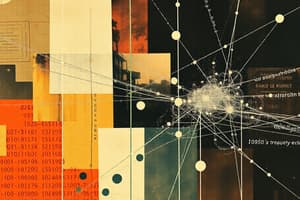Podcast
Questions and Answers
The purpose of data frames is to arrange data with each row as an observation and each column representing a variable.
The purpose of data frames is to arrange data with each row as an observation and each column representing a variable.
True (A)
Hadley Wickham developed the dplyr package as an enhanced version of his original plyr package.
Hadley Wickham developed the dplyr package as an enhanced version of his original plyr package.
True (A)
The select() function in dplyr extracts specific rows from a data frame based on given conditions.
The select() function in dplyr extracts specific rows from a data frame based on given conditions.
False (B)
To remove columns from a data frame, you can use the select() function with a minus sign (-) before the column names.
To remove columns from a data frame, you can use the select() function with a minus sign (-) before the column names.
The arrange() function is used to rename variables in a data frame.
The arrange() function is used to rename variables in a data frame.
The mutate() function can add new variables or transform existing ones within a data frame.
The mutate() function can add new variables or transform existing ones within a data frame.
Using summarize() in conjunction with group_by() allows for the calculation of summary statistics within defined groups of a data frame.
Using summarize() in conjunction with group_by() allows for the calculation of summary statistics within defined groups of a data frame.
The %>% operator, known as the "pipe," is used to combine multiple dplyr functions in a sequence.
The %>% operator, known as the "pipe," is used to combine multiple dplyr functions in a sequence.
In dplyr, the rename() function has the new variable name on the right-hand side of the equal sign and the old name on the left.
In dplyr, the rename() function has the new variable name on the right-hand side of the equal sign and the old name on the left.
The new name is on the left, and the old name is on the rightThe filter() function in dplyr allows for complex logical sequences to be used for extracting data subsets.
The new name is on the left, and the old name is on the rightThe filter() function in dplyr allows for complex logical sequences to be used for extracting data subsets.
Flashcards are hidden until you start studying



